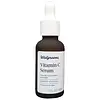What's inside
What's inside
 Key Ingredients
Key Ingredients

 Benefits
Benefits

 Concerns
Concerns

No concerns
 Ingredients Side-by-side
Ingredients Side-by-side

Water
Skin ConditioningButylene Glycol
Humectant3-O-Ethyl Ascorbic Acid
Skin ConditioningGlycerin
HumectantDipropylene Glycol
HumectantPentylene Glycol
Skin ConditioningPolyacrylate Crosspolymer-6
Emulsion Stabilising1,2-Hexanediol
Skin ConditioningSodium Citrate
BufferingBis-PEG-18 Methyl Ether Dimethyl Silane
EmollientAllantoin
Skin ConditioningHydroxyacetophenone
AntioxidantEthylhexylglycerin
Skin ConditioningHydroxyethylpiperazine Ethane Sulfonic Acid
BufferingArginine
MaskingXanthan Gum
EmulsifyingCitric Acid
BufferingDipotassium Glycyrrhizate
HumectantDisodium EDTA
Stephania Tetrandra Root Extract
Skin ConditioningPPG-26-Buteth-26
Skin ConditioningPEG-40 Hydrogenated Castor Oil
EmulsifyingTocopheryl Acetate
AntioxidantWater, Butylene Glycol, 3-O-Ethyl Ascorbic Acid, Glycerin, Dipropylene Glycol, Pentylene Glycol, Polyacrylate Crosspolymer-6, 1,2-Hexanediol, Sodium Citrate, Bis-PEG-18 Methyl Ether Dimethyl Silane, Allantoin, Hydroxyacetophenone, Ethylhexylglycerin, Hydroxyethylpiperazine Ethane Sulfonic Acid, Arginine, Xanthan Gum, Citric Acid, Dipotassium Glycyrrhizate, Disodium EDTA, Stephania Tetrandra Root Extract, PPG-26-Buteth-26, PEG-40 Hydrogenated Castor Oil, Tocopheryl Acetate
Water
Skin ConditioningAscorbic Acid
AntioxidantDimethicone
EmollientGlycerin
HumectantAlcohol Denat.
AntimicrobialPotassium Hydroxide
BufferingPolysilicone-11
Pentaerythrityl Tetraethylhexanoate
EmollientAcetyl Dipeptide-1 Cetyl Ester
Skin ConditioningAdenosine
Skin ConditioningSodium Hyaluronate
HumectantTocopherol
AntioxidantSilica
AbrasiveAmmonium Polyacryloyldimethyl Taurate
Emulsion StabilisingButylene Glycol
HumectantCaprylyl Glycol
EmollientC13-14 Isoparaffin
EmollientHydroxyethylcellulose
Emulsion StabilisingLaureth-7
EmulsifyingPEG-20 Methyl Glucose Sesquistearate
EmulsifyingPoloxamer 338
EmulsifyingPolyacrylamide
Sorbitan Laurate
EmulsifyingXanthan Gum
EmulsifyingBis-PEG/PPG-16/16 PEG/PPG-16/16 Dimethicone
EmollientCaprylic/Capric Triglyceride
MaskingPentaerythrityl Tetra-Di-T-Butyl Hydroxyhydrocinnamate
AntioxidantSalicylic Acid
MaskingParfum
MaskingWater, Ascorbic Acid, Dimethicone, Glycerin, Alcohol Denat., Potassium Hydroxide, Polysilicone-11, Pentaerythrityl Tetraethylhexanoate, Acetyl Dipeptide-1 Cetyl Ester, Adenosine, Sodium Hyaluronate, Tocopherol, Silica, Ammonium Polyacryloyldimethyl Taurate, Butylene Glycol, Caprylyl Glycol, C13-14 Isoparaffin, Hydroxyethylcellulose, Laureth-7, PEG-20 Methyl Glucose Sesquistearate, Poloxamer 338, Polyacrylamide, Sorbitan Laurate, Xanthan Gum, Bis-PEG/PPG-16/16 PEG/PPG-16/16 Dimethicone, Caprylic/Capric Triglyceride, Pentaerythrityl Tetra-Di-T-Butyl Hydroxyhydrocinnamate, Salicylic Acid, Parfum
 Reviews
Reviews

Ingredients Explained
These ingredients are found in both products.
Ingredients higher up in an ingredient list are typically present in a larger amount.
Butylene Glycol (or BG) is used within cosmetic products for a few different reasons:
Overall, Butylene Glycol is a safe and well-rounded ingredient that works well with other ingredients.
Though this ingredient works well with most skin types, some people with sensitive skin may experience a reaction such as allergic rashes, closed comedones, or itchiness.
Learn more about Butylene GlycolGlycerin is already naturally found in your skin. It helps moisturize and protect your skin.
A study from 2016 found glycerin to be more effective as a humectant than AHAs and hyaluronic acid.
As a humectant, it helps the skin stay hydrated by pulling moisture to your skin. The low molecular weight of glycerin allows it to pull moisture into the deeper layers of your skin.
Hydrated skin improves your skin barrier; Your skin barrier helps protect against irritants and bacteria.
Glycerin has also been found to have antimicrobial and antiviral properties. Due to these properties, glycerin is often used in wound and burn treatments.
In cosmetics, glycerin is usually derived from plants such as soybean or palm. However, it can also be sourced from animals, such as tallow or animal fat.
This ingredient is organic, colorless, odorless, and non-toxic.
Glycerin is the name for this ingredient in American English. British English uses Glycerol/Glycerine.
Learn more about GlycerinWater. It's the most common cosmetic ingredient of all. You'll usually see it at the top of ingredient lists, meaning that it makes up the largest part of the product.
So why is it so popular? Water most often acts as a solvent - this means that it helps dissolve other ingredients into the formulation.
You'll also recognize water as that liquid we all need to stay alive. If you see this, drink a glass of water. Stay hydrated!
Learn more about WaterXanthan gum is used as a stabilizer and thickener within cosmetic products. It helps give products a sticky, thick feeling - preventing them from being too runny.
On the technical side of things, xanthan gum is a polysaccharide - a combination consisting of multiple sugar molecules bonded together.
Xanthan gum is a pretty common and great ingredient. It is a natural, non-toxic, non-irritating ingredient that is also commonly used in food products.
Learn more about Xanthan Gum